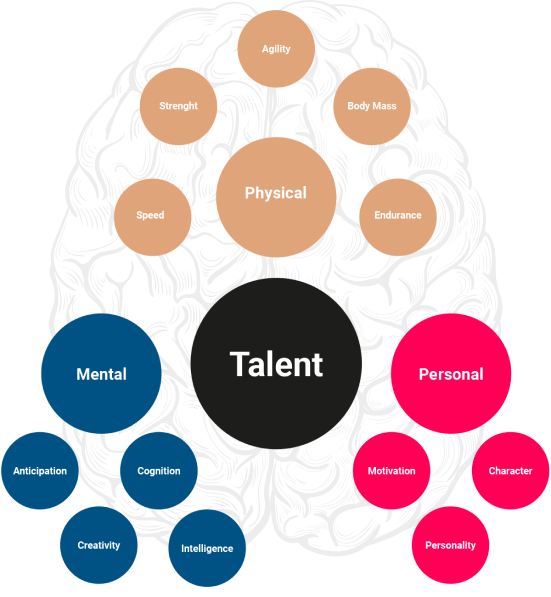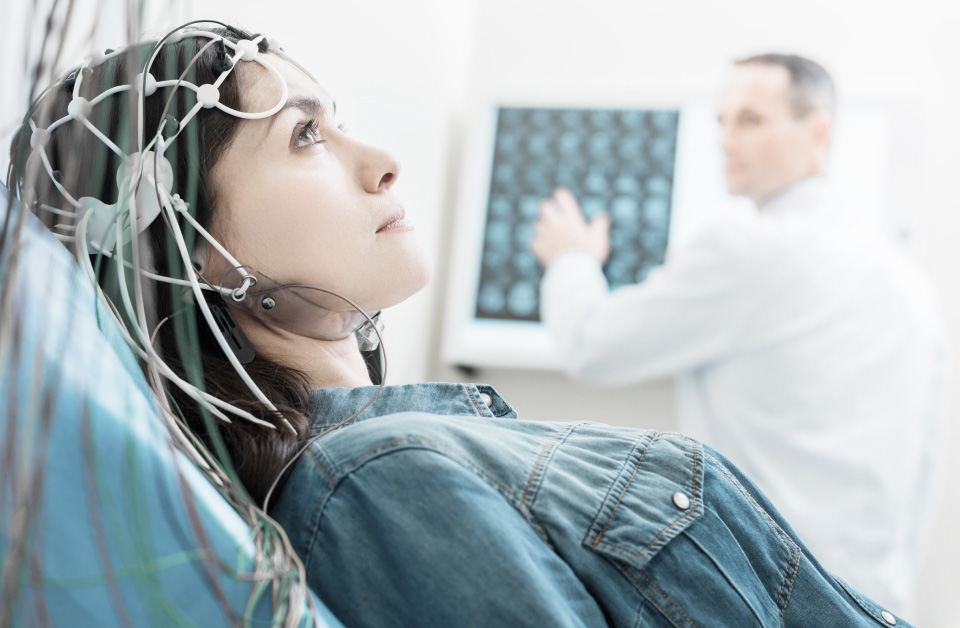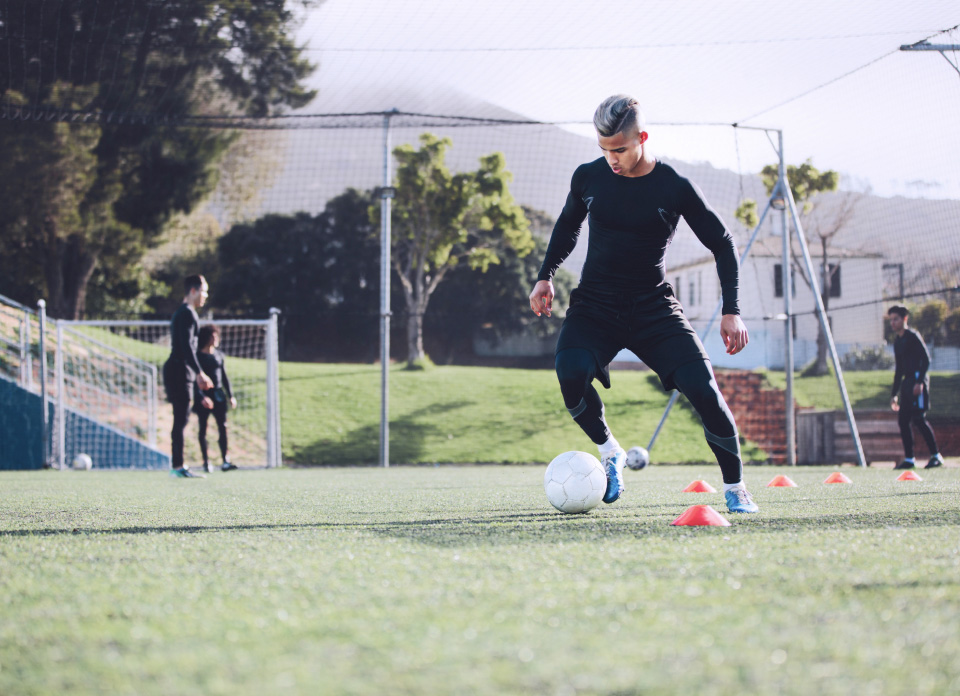Talent is a very complex phenomenon that has never been completely explained. The only thing that is certain is that for the discovery and development of talent, a combination of several factors must be taken into account: mental, physical and personal and our methodology is a sure way to identify mental talent.
We don’t just discover aptitude – instead, we go a step further and identify the real talent, using a unique, innovative and scientifically proven method.
Our extensive research has proven that average and gifted individuals use different parts of their brain in performing the same task. Difference is in the brain!


Our methodology researches and identifies existing talents, measuring the activities in the brain using Electroencephalography (EEG) with the aim of selecting and identifying future extraordinary individuals.
We submit tested individuals to visual and physical stimuli and measure their anticipation levels. Anticipation is a process in which the individual imagines the results of some action before the action actually took place, and is a key factor of success, performance and reaction.
Our method is based on a scientific discovery that average and gifted individuals use different parts of the brain in performing the same task. Long-term studies have shown that the training process cannot change pronounced differences in the magnitude and distribution of brain activity, which means that it is very probable that mental talent is genetically determined and thus can be measured at the start of the training process.
Highly talented persons use the frontal lobe when analyzing the subject, whereas in talented persons activity predominates in the region of the temporal lobe. Pronounced differences in the magnitude and distribution of brain activity point to different mechanisms of brain processing and to differences in the functional brain organization of average and talented persons. This scientific breakthrough has been reported on in the prestigious scientific journal Nature and has received significant media attention worldwide.
Multiple scientific studies were conducted from 2001 to 2009. Through testing hundreds of talents, the method was proven to be unique and reliable – the impressive results showed that a larger number of talents achieved peak performance and results within the areas they were tested in.

References in Scientific Papers
ACHENBACH, C., 2004.
Untersuchung der cerebellären und hippocampalen Aktivierungsmuster bei der differentiellen Lidschlagkonditionierung mittels Magnetoencephalographie und funktioneller Magnetresonanztomographie. Justus-Liebig-Universität Gießen, Univ., Diss.
AINE, C.J., STEPHEN, J.M., 2002.
MEG Studies of Visual Processing. In: A. Zani, A.M. Proverbio eds. The Cognitive Electrophysiology of Mind and Brain. Academic Press: Elsevier Science (USA), 93-142.
BART, W.M., ATHERTON, M., 2003.
The neuroscientific basis of chess playing: Applications to the development of talent and education. American Educational Research Association national meeting. [paper presentation, peer reviewed, invited]. Available from: http://www.tc.umn.edu/~athe0007/BNEsig/papers/NeuroscientificBasisOfChess.pdf
BILALIĆ, M., LANGNER, R., ERB, M., GRODD, W., 2010.
Mechanisms and Neural Basis of Object and Pattern Recognition: A Study With Chess Experts. Journal of Experimental Psychology, 139(4), 728 – 742.
BLANCH, A., GARCÍA, H., LLAVERIA, A., ALUJA, A., 2017.
The Spearman’s law of diminishing returns in chess. Personality and Individual Differences, 104, 434-441.
BLIGNAUT, P.J., BEELDERS, T.R., SO, C-Y., 2008.
The visual span of chess players. Proccedings of the 2008 symposium on Eye tracking research, Savannah, Georgia, USA, 165-171.
BORSBOOM, D., EPSKAMP, S., KIEVIT, R.A., CRAMER, A.O.J., SCHMITTMANN, V.D., 2011.
Transdiagnostic Networks: Commentary on Nolen-Hoeksema and Watkin (2011). Perspectives on Psychological Science, https://doi.org/10.1177/1745691611425012.
CAMPITELLI, G., GOBET, F., HEAD, K., BUCKLEY, M., PARKER, A., 2007.
Brain Localisation of Memory Chunks in Chessplayers. International Journal of Neuroscience. Pre Print: Centre for Cognition and Neuroimaging, Brunel University, West London, Uxbridge. Available from: http://hdl.handle.net/2438/677
CAMPITELLI, G., GOBET, F., PARKER, A., 2005.
Structure and Stimulus Familiarity: A Study of Memory in Chess-Players with Functional Magnetic Resonance Imaging. The Spanish Journal of Psychology, 8 (2), 238-245.
CROSS, S.S., 2005.
Aptitude testing and assessment of training progress in histopathology. Current Diagnostic Pathology, 11 (5), 299-307.
DAI, D.Y., SWANSON, J.A., CHENG, H., 2011.
State of Research on Giftedness and Gifted Education: A Survey of Empirical Studies Published During 1998—2010 (April). Gifted Child Quarterly, https://doi.org/10.1177/0016986210397831.
DREYFUS, H.L., 2006.
Overcoming the myth of the mental. Topoi, 25 (1-2), 43-49.
DREYFUS, H.L., 2005.
Merleau-Ponty and Recent Cognitive Science. In: T. Carman, M.B.N. Hansen eds. The Cambridge companion to Merleau-Ponty. Cambridge University Press, 129-150.
DREYFUS, H.L., 2002.
A Phenomenoloy of Skill Acquisition as the basis for a Merleau-Pontian Non-representationalist Cognitive Science. University of California, Berkeley Press, 1-20. Available from: http://socrates.berkeley.edu/~hdreyfus/pdf/MerleauPontySkillCogSci.pdf
DREYFUS, S.E., 2004.
The Five-Stage Model of Adult Skill Acquisition. Bulletin of Science, Technology & Society, 24 (3), 177-181.
DUAN, X., LIAO, W., LIANG, D., QIU, L., GAO, Q., LIU, C., GONG, Q., CHEN, H., 2012.
Large-Scale Brain Networks in Board Game Experts: Insights from a Domain-Related Task and Task-Free Resting State. PLoS ONE 7(3): e32532. doi:10.1371/journal.pone.0032532, Volume 7, Issue 3, e32532.
DUAN, X., LONG, Z., CHEN, H., LIANG, D., QIU, L., HUANG, X., LIU, T.C.Y., GONG, Q., 2014.
Functional organization of intrinsic connectivity networks in Chinese-chess experts. Brain Research, 1558, 33-43.
ELBERT, T., 2006.
Studying higher cognition with magnetoencephalography (MEG). Parmenides Workshop 13, Neural Correlates of Thinking (NCT), Island of Elba, Italy.
ELLIS, J. 2002.
Deep Blue Intelligence. Artificial intelligence Assignment. Charles Darwin University Australia, School of Information Technology. Lecture. Available from: http://www.cs.ntu.edu.au/homepages/rsvp/archive04S2/archive/sit371/Talks2002/JEllis.doc
FATTAHI, F., GESHANI, A., JAFARI, Z., JALAIE, S., SALMAN MAHINI, M., 2015.
Auditory memory function in expert chess players. Medical Journal of The Islamic Republic of Iran, 29, 275.
FUENTES, J.P., VILLAFAINA, S., COLLADO-MATEO, D., DE LA VEGA, R., GUSI, N., CLEMENTE-SUÁREZ, V.J. 2018.
Use of Biotechnological Devices in the Quantification of Psychophysiological Workload of Professional Chess Players. Journal of Medical Systems, 42, 40.
FUENTES-GARCÍA, J.P., PEREIRA, T., CASTRO, M.A., CARVALHO SANTOS, A., VILLAFAINA, S., 2019.
Psychophysiological stress response of adolescent chess players during problem-solving tasks. Physiology & Behavior 209, 112609.
FUENTES-GARCÍA, J.P., PEREIRA, T., CASTRO, M.A., CARVALHO SANTOS, A., VILLAFAINA, S., 2019.
Heart and Brain Responses to Real Versus Simulated Chess Games in Trained Chess Players: A Quantitative EEG and HRV Study. International Journal of Environmental Research and Public Health, 16, 5021.
FUENTES-GARCÍA, J.P., VILLAFAINA, S., COLLADO-MATEO, D., DE LA VEGA, R., OLIVARES, P.R., CLEMENTE-SUÁREZ, V.J., 2019.
Differences Between High vs. Low Performance Chess Players in Heart Rate Variability During Chess Problems. Frontiers in Psychology, Vol 10, Art. 409.
FUENTES-GARCÍA, J.P., VILLAFAINA, S., COLLADO-MATEO, D., CANO-PLASENCIA, R., GUSI, N., 2020.
Chess Players Increase the Theta Power Spectrum When the Difficulty of the Opponent Increases: An EEG Study. International Journal of Environmental Research and Public Health, 17, 46.
GASER, C., SCHLAUG, G., 2003.
Brain Structures Differ between Musicians and Non-Musicians. The Journal of Neuroscience, 23 (27), 9240-9245.
GOBET, F., DE VOOGT, A., RETSCHITZKI, J., 2004.
Movies in mind: The psychology of board games. Psychology Press, 184-186.
GOBET, F., CHARNES, N., 2007.
Expertise in Chess. In: K.A. Ericsson, N. Charness, P.J. Feltovich, R.R., Hoffman eds. Cambridge Handbook of Expertise and Expert Performance. Cambridge University Press, New York, USA, 533-534.
GOBET, F., CHASSY, P., 2007.
Season of birth and chess expertise. Journal of Biosocial Science, in Press. Preprint available from: http://hdl.handle.net/2438/736
HAKER, M., MEYER, A., KALANTARY, B., POLANI, D., MARTINETZ, T., 2002. Team
Team Description for Baltic Lubeck 2002. In Kaminka, G. A., Lima, P. U., and Rojas, R., editors, RoboCup 2002: Robot Soccer World Cup VI, Fukuoka, Japan. Pre-Proceedings. Also Available from: Institute for Neuro- and Bioinformatics, University of Lubeck, Germany http://www.inb.mu-luebeck.de/robocup/robocup-e.html
HÄMÄLÄINEN, M., HARI, R., 2002.
Magnetoencephalographic Characterization of Dynamic Brain Activation: Basic Principles and Methods of Data Collection and Source Analysis. In: A.W. Toga, J.C. Mazziotta eds. Brain Mapping: The Methods, 2nd edition. Elsevier Science (USA), 227-250.
HÄNGGI, J., BRÜTSCH, K., SIEGEL, A.M., JÄNCKE, L., 2014.
The architecture of the chess player׳s brain. Neuropsychologia, 62, 152-162.
HERRMANN, D.J., YODER, C.Y., GRUNEBERG, M., PAYNE, D.G., 2006.
Applied Cognitive Psychology. Psychology Press, 170.
JUNG, R.E., HAIER, R.J., 2007.
The Parieto-Frontal Integration Theory (P-FIT) of intelligence: Converging neuroimaging evidence. Behavioral And Brain Sciences, 30, 135-187.
KALAT, J.W., 2004.
Biological Psychology. Thomson, Wadsworth.
KENDRICK K., 2003.
Memories are made of this; but what about intellect? Lecture, Professor Keith Kendrick, Gresham College, London, UK. Transcript. Available from: http://www.gresham.ac.uk/event.asp?PageId=45&EventId=140
KRAWCZYK, D.C., BOGGAN, A.L., MCCLELLAND, M.M., BARTLETT, J.C., 2011.
The neural organization of perception in chess experts. Neuroscience Letters, 499, 64-69.
KUN, H.L., YU, Y.C., JEREMY, R.G., SUN, H.C., JEONG-HO, C., SEUNGHEUN, L., KYUNGJIN, K., 2006.
Neural correlates of superior intelligence: Stronger recruitment of posterior parietal cortex. NeuroImage, 29, 578-586.
LANGNER, R., EICKHOFF, S.B., BILALIĆ, M., 2019.
A network view on brain regions involved in experts’ object and pattern recognition: Implications for the neural mechanisms of skilled visual perception. Brain and Cognition, 131, 74-86.
LEE, B., PARK, J.Y., JUNG, W.H., KIM, H.S., OH, C.H., JANG, J.H., KANG, D.H., KWON, J.S., 2010.
White matter neuroplastic changes in long-term trained players of the game of “Baduk” (GO): A voxel-based diffusion-tensor imaging study. NeuroImage, 52, 9-19.
LEE, K.H., CHOI, Y.Y., GRAY, J.R., CHO, S.H., CHAE, J.H., LEE, S., KYUNGJIN, K., 2006.
Neural correlates of superior intelligence: Stronger recruitment of posterior parietal cortex. NeuroImage, 29 (2), 578-586.
LEIRER, V.M., WIENBRUCH, C., PAUL-JORDANOV, I., KOLASSA, S., ELBERT, T., KOLASSA, I.T., 2010.
Hippocampal activity during the transverse patterning task declines with cognitive competence but not with age. BMC Neuroscience, 11, 113, 5237.
LERNER, C.S., 2006.
Reasonable Suspicion and Mere Hunches. George Mason University School of Law. The Berkeley Electronic Press (bepress).
MAGUIRE, E.A., VALENTINE, E.R., WILDING, J.M., KAPUR, N., 2003.
Routes to remembering: the brains behind superior memory. Nature Neuroscience, 6 (1), 90–95.
MANN, M.W., GUEGUEN, B., GUILLOU, S., DEBRAND, E., SOUFFLET, C., 2004.
Chess-playing epilepsy: a case report with video-EEG and back averaging. Epileptic Disord, 6 (4), 293-296.
OWENS, P., 2005.
Cognitive load theory and music instruction. Dissertation. Sydney, Australia: The University of New South Wales.
PEREIRA, T., ANTÓNIO CASTRO, M., VILLAFAINA, S., CARVALHO SANTOS, A., FUENTES-GARCÍA, J.P., 2020.
Dynamics of the Prefrontal Cortex during Chess-Based Problem-Solving Tasks in Competition-Experienced Chess Players: An fNIR Study. Sensors, 20, 3917.
POUMAY, M., (Ed), 2001.
Why and How using Case Based Learning Methods (CBLMs), a LabSET report for Hewlett Packard in San-Francisco, University of Liège. Available from: http://www.ulg.ac.be/labset/projets/hp/pgTHEORIESSchemataandChessplayers.htm http://www.ulg.ac.be/labset/projets/hp/pgREFERENCES.htm
REID, V.M., HOEHL, S., LANDT, J., STRIANO, T., 2008.
Human infants dissociate structural and dynamic information in biological motion: evidence from neural systems. Oxford University Press. Social Cognitive and Affective Neuroscience (Scan), 1-7.
RORING, R.W., 2008.
Reviewing expert chess performance: A production-based theory of chess skill. Dissertation. Department of Psychology, Florida State University, Tallahassee, Florida, USA, 25.
RORING, R.W., NANDAGOPAL, K., ERICSSON, A.K., 2007.
Can Parieto-Frontal Integration Theory be extended to account for individual differences in skilled and expert performance in everyday life? Department of Psychology, Florida State University, Tallahassee, Florida 32306-1270. Available from: http://www.bbsonline.org/Preprints/Jung-10182005/Commentators/Word_docs/Roring.doc
SLOTNICK, S.D., MOO, L.R., KRAUT, M.A., LESSER, R.P., HART, J.JR., 2002.
Interactions between thalamic and cortical rhythms during semantic memory recall in human. Proceedings of the National Academy of Sciences of the United States of America, 99 (9), 6440-6443.
SONG, L., PENG, Q., LIU, S., WANG J., 2020.
Changed hub and functional connectivity patterns of the posterior fusiform gyrus in chess experts. Brain Imaging and Behavior, 14, 797-805.
SONG, L., GE, Y., LONG, J., DONG, P., 2020.
Altered Intrinsic and Casual Functional Connectivities of the Middle Temporal Visual Motion Area Subregions in Chess Experts. Frontiers in Neuroscience, 14, 605986.
SOUZA, G.D.S., DE OLIVEIRA, J.N., SILVEIRA, L.C.D.L., 2009.
Muito jogo para ser ciência, muita ciência para ser jogo. Neurociências Volume IV Nº 2: Opiniões. Atlantica Editora, São Paulo, Brasil. Available from: http://www.atlanticaeditora.com.br.
TAMMET, D., 2009
Embracing The Wide Sky. A tour across the horizons of the human mind. Hodder & Stoughton, London, UK.
TIETZE, H., 2003
Die Neuronale Organisation des konzeptuellen Wissens. Prüfung der Tiefenrepräsentation mit Hilfe des EEGs. Friedrich-Schiller-Universität Jena, Univ., Diss.
TODD, H.C., 2002.
The Neural Basis of the Search for Meaning: A time Scale Approach. Ideas for Creative Research in Neurobiology, A John Templeton Foundation Program, 35-40. Available from: http://www.templetonfoundation.net/pdf/CreativeResearchIdeas2002.pdf
TODD, H.M., 2005.
Computer-aided organic synthesis. Chemical Society Reviews, 34, 247 – 266.
TRAN-DUY, A., SMERDON, D.C., CLARKE, P.M., 2018.
Longevity of outstanding sporting achievers: Mind versus muscle. PLOS ONE https://doi.org/10.1371/journal.pone.0196938.
VAN DER MAAS, H.L.J., WAGENMAKERS E.J., 2005.
A psychometric analysis of chess expertise. The American Journal of Psychology, 118 (1), 29-60.
VILLAFAINA, S., COLLADO-MATEO, D., CANO-PLASENCIA, R., GUSI, N., FUENTES, J.P., 2019.
Electroencephalographic response of chess players in decision-making processes under time pressure. Physiology & Behavior, 198, 140-143.
VILLAFAINA, S., CASTRO, M.A., PEREIRA, T., CARVALHO SANTOS, A., FUENTES-GARCÍA, J.P., 2021.
Neurophysiological and autonomic responses of high and low level chess players during difficult and easy chess endgames – A quantitative EEG and HRV study. Physiology & Behavior, 237, 113454.
WANG, Y., ZUO, C., WANG, D., TAO, S., LEIHAO, 2020.
Reduced Thalamus Volume and Enhanced Thalamus and Fronto-Parietal Network Integration in the Chess Experts. Cerebral Cortex, 30, 5560–5569.
WAN, X., NAKATANI, H., UENO, K., ASAMIZUYA, T., CHENG, K., TANAKA, K., 2011.
The Neural Basis of Intuitive Best Next-Move Generation in Board Game Experts. Science, 331, 341-346.
